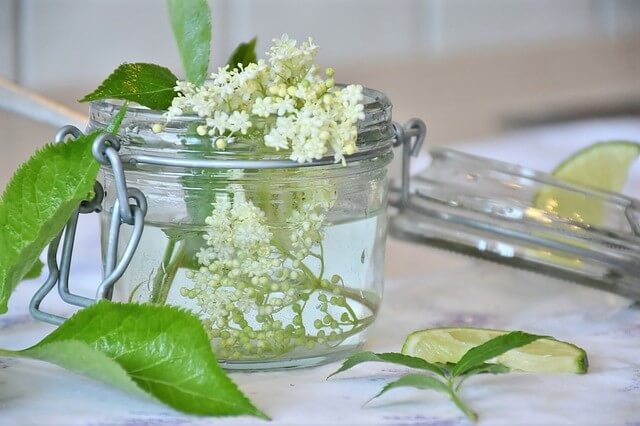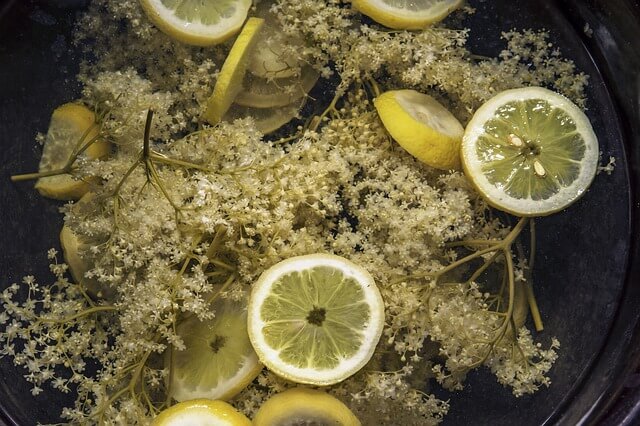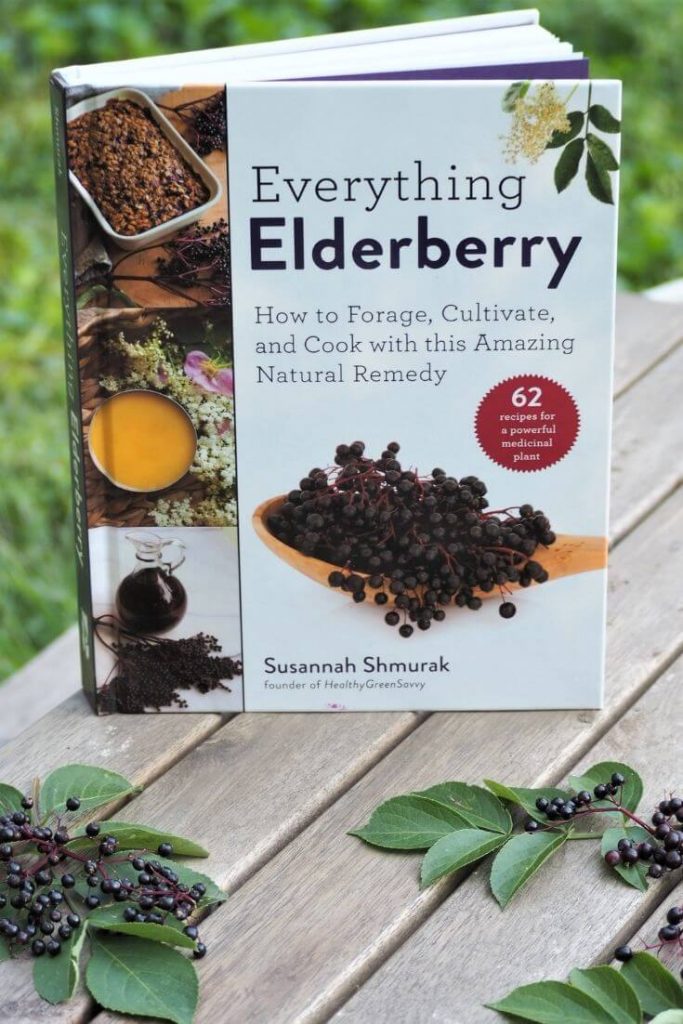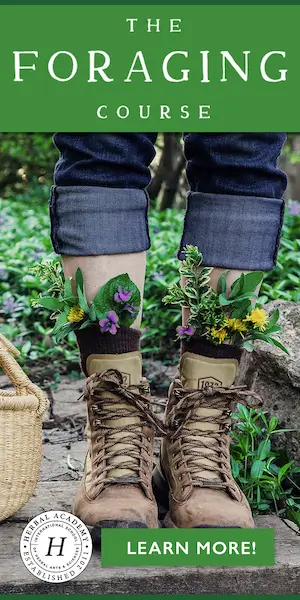Last Updated on September 17, 2024
Is it elderflower season where you are? If so, fragrant and medicinal elderberry blossoms are everywhere! Help yourself to some free deliciousness by foraging elderflowers from an elderberry plant near you. You can also purchase dried elderflowers or elderflower syrup to reap elderflower’s benefits. But first, what is elderflower?
What is Elderflower?
You’ve probably heard of elderberries, the natural remedy for colds and flu that’s gotten so popular you can find it in every supermarket and grocery store these days. Elderflower is simply the flower of the same plant, Sambucus nigra, or its North American cousin, Sambucus canadensis.
Though not as well known as the berry it will become, it turns out elderflower (or elderberry flower if you prefer) also has numerous health benefits and has been used for centuries as a remedy to address a wide variety of complaints.
It’s also a very popular flavoring for many delicious treats.
Are Elderflowers Edible?
If you’ve wondered, can you eat elderflowers, you’ll be pleased to know that yes, indeed elderflowers are edible. In fact, they’re delicious, adding a truly special flavor to drinks and desserts.
You’re most likely to have come across elder flowers as a flavoring for liqueurs, especially the popular St. Germain, or possibly in the increasingly popular elderflower syrup used to flavor cocktails, sodas, and delicious desserts.
Elderflower is also a beneficial medicinal herb that’s worth getting to know, in part because it’s so easy to forage from these widespread plants. How wonderful to be able to bring home bags of this delicious medicinal flower to have on hand when you need them.
Related: How to Make Honeysuckle Syrup and Other Delightful Honeysuckle Recipes
What Does Elderflower Taste Like?
Fresh elderflower has a light floral scent with a hint of pineapple. But taste is a pretty individual thing, and plants grown in different conditions and climates will likely also have different flavors. Some people find elderflower’s flavor “musky” while others find the taste similar to lychee.
The elderflower products I’ve tried from Europe (made with Sambucus nigra blossoms) have a more prominent lychee flavor and scent than the ones I’ve made myself from elderflowers foraged from my local Sambucus canadensis. They’re both fantastic, just different.
A tea brewed from fresh elderberry flowers is surprisingly light but still fruity and delicious. Dried elderflowers make a lovely tea also, though the flavor changes. I think it’s fun to enjoy these beautiful gifts from nature in all the different ways we can!
If you’re looking for a special flavoring for a cake or mixed drinks, you can make a simple elderflower syrup (sometimes called cordial) or purchase a premade one. Ikea sells a popular elderberry flower syrup, though apparently it’s not always easy to get since demand increased after Harry & Meghan’s royal wedding cake included elderflower. In Europe you might find elderflower pressé, a carbonated drink, on grocery store shelves.
Norm’s Farms also carries elderflower syrup you can buy here.
The popular liqueur made from elder flowers gives a delicate floral flavor to numerous mixed drinks, everything from sangria to martinis.
Most often paired with lemon or strawberry, elderflower also works well with melon and other fruits.
Elderflower Benefits & Medicinal Uses
Like so many other underappreciated plants, elderberry flowers not only taste amazing but have some potent medicinal benefits as well. Hibiscus, lemon balm, yarrow, dandelion, nettle, and spruce (for winter spruce tea and springtime spruce tips) are some of my other favorites, many of which can be combined to complement elder flower. Here are some herbal tea recipes to help you get started making your own customized herbal tea blends, using purchased or wild herbs you forage.
Herbalists have long used elderflower for fevers and colds. Exceptionally rich in antioxidants, elder flowers have antiviral and antimicrobial properties as well.
A tea brewed from elderflower, yarrow, and peppermint is a traditional soother for respiratory inflammation. You’ll find this combination in Herbal Cold Care Tea from Traditional Medicinals, which can be found in the tea aisle of many supermarkets and natural food stores.
Herbalists use elderflower as an anti-inflammatory that’s especially beneficial for treating respiratory symptoms. Rosemary Gladstar highlights elderflower’s diaphoretic (sweat-inducing) properties, which make it a popular choice for reducing fevers. Also useful for helping you cool down on hot days, elderflower can be served in refreshing iced teas, either on its own or combined with other cooling herbs.
Elder flower is a popular herbal remedy for coughs and benefits frayed nerves. If you’ve ever had a Ricola cough drop, you’ve had a little medicinal elder flower. Here’s more on incorporating elderflower into your cold care routine from Studio Botanica.
Elderflower also has diuretic and mild laxative effects.
The Herbal Academy reports that “A strong infusion may be used as a gargle for sore throats, and as a compress for headaches. A cold infusion of the flowers has been used as an eye wash for inflamed eyes, for both man and dogs.”
Ongoing scientific research is exploring elderflower’s use as a therapy for Parkinson’s disease, breast cancer, and for controlling blood sugar and cholesterol. A traditional therapy for diabetes, elder flower is being studied for its effect on insulin resistance.
Used topically, elderflower can reduce swelling and may relieve arthritis pain. It’s sometimes used in homemade skincare recipes for its soothing and smoothing abilities. You can buy many products made with elder flowers on Etsy, or make your own using the recipes below.
Here are some wonderful ways to use elderflower in your skincare routine:
Elderflower Rosehip Salve (The Nerdy Farm Wife)
Elderflower Infusion Oil (Simply Beyond Herbs)
Elderflower Anti-Aging Serum (Joybilee Farm)
>>To find out more about what science tells us about the benefits of elderflower and elderberry, expert growing advice, plus 62 delicious recipes, grab a copy of Everything Elderberry. It involved months of research, dozens of interviews, and a ton of kitchen experiments. It contains information on elderberries and elderflowers you can’t find anywhere else. I hope you’ll love it!
If you’re looking for more great books on using medicinal plants for your home library, be sure to check out this list of the best herbalism books.
Precautions Using Elderflower
**Much of the elderberry plant contains compounds considered toxic. Eat only the flowers and cooked berries, NOT the stems or leaves.**
- Elderflower is not recommended for use while pregnant or nursing.
- If you take diabetes medication, consult a doctor before consuming elder flowers.
- Consume in moderation to avoid stomach upset.
- Stop using elder flower at least two weeks prior to surgery as it may interfere with blood clotting.

Photo credit: RitaE
I get so many questions about how to use elderberry and elderberry blossoms that I wrote a short downloadable guide to using elderflowers and elderberries safely and effectively. You can get yours by filling in the form here.
Where to Find Elderflowers: Forage, Grow, or Buy
You can forage your own elder blossoms or purchase them dried. Elderflower fans will tell you the flavor of fresh elderberry blossoms is far superior, so it’s worth finding some growing wild near you or cultivating some of your own.
Elder flowers (a.k.a. elderberry bushes) grow well in much of North America and Europe, and they’re easy to grow yourself if you have space. Several cultivars are available, and since they have different bloom times, planting different elderberry varieties can help extend elderflower’s short season. Here’s everything you need to know about growing elderberries.
Foraging Elderflower
If foraging’s more your jam, one way to find elderflowers in your area is to positively identify plants once the berries are ripe and remember where they were the following season. Or better still, find someone in your area to point out a few elder plants during flowering time; once you’ve seen them, you’ll have no trouble recognizing these beauties in bloom.
If you’re uncertain where to look in your area, ask around on email lists and online groups. You might be surprised how much local knowledge there is about these beautiful and medicinal plants.
To learn more about correctly identifying elderflower and avoiding poisonous look alikes, check out this important info on elderflower identification.
*Be sure to use a good foraging guide or go with a veteran forager, and watch out for toxic plants that could be mistaken for elderberry.* Red elderberry (Sambucus racemosa), for instance, flowers a month earlier and has a different-shaped flower head. Some herbalists use the flowers from red elder plants similarly to those of black elderberry, but the plant is much higher in compounds that make people sick.
Always use multiple features when identifying plants. Look carefully at the leaves, bark, and growth habit before you decide it’s an elderberry bush and start harvesting elderberry flowers.
If you’re also interested in harvesting elderberries, read this guide to elderberry identification.
If you’d like to become more expert in the art of foraging, the Herbal Academy has an online foraging course that teaches plant identification and ethical wildcrafting practices.
Tips for Foraging Elderflowers

Photo credit: Susannah Shmurak
Remember that if you pick the flowers, the plant won’t make berries. Leave plenty of elderflowers on the plant so you can enjoy foraging elderberries a couple months later and put up plenty of homemade elderberry syrup for cold and flu season. Here’s how to make elderberry tea from dried elderberries.
To keep elderberry flowers fresh, I’ve found it helpful to bring along an insulated bag with some freeze packs. Put your flower heads in the bag, and they’ll keep much longer than if you leave them loose in a basket.

Skip umbels that haven’t fully opened yet. Come harvest them later or leave them to form elderberries. (Photo credit: alsterkoralle)
The season for picking elderflowers lasts about 4-6 weeks, as the umbels on a single plant will bloom at different times, and different plants in different growing conditions will bloom earlier or later.
If you love the idea of foraging flowers like elderberry blossoms, you’ll be thrilled to learn that there are more than 150 other edible flowers worth checking out.
If you lack the time or inclination or if there aren’t elderflowers growing near you, there are a number of options for buying dried elderflowers online. You might also try this bagged version from Republic of Tea.
One of the top sources for high-quality herbs is Mountain Rose Herbs, where you’ll find a stunning array of organic loose herbs and spices at very reasonable prices.
Using Elderflower: How to Preserve Elderberry Flowers
Most elderflower devotees like to use them right after picking to maximize the flavor they can extract. Elderberry flowers start to wilt and brown within a couple of hours of picking. You can refrigerate your elder blossoms in a container or paper bag for up to 24 hours if you’re not going to get to them immediately.
But dried flowers are also very useful medicinally. Herbalist Matthew Wood reports that “properties of the flowers change according to whether they are fresh or dried, or served hot or cold” (432). He notes that “fresh flowers more purgative, elderflowers also harder on stomach. Dried they lose purgative properties.” It’s a warm infusion of dried elder flowers that’s generally used for treating fever.
Elder flower umbels (the flowerheads containing scores of blossoms) are easy to snip from the plant, but depending on what you’re doing with them, preparing them afterward can be a bit labor-intensive. For some elderflower recipes you can leave on the upper bits of stem. For others, you need to remove all the little blossoms from their stems, which not only don’t taste great, but also contain compounds that can cause stomach upset.
How to De-Stem Elderflowers
I spent many hours de-stemming elderflowers while researching my new book, Everything Elderberry. I hung out with elderberry growers, herbalists, jam makers, and even a local distiller learning how they put these ephemeral blossoms to use.
I pitched in with huge boxes of elderberry blossoms destined to become a locally-made elderflower liqueur, where the preferred technique was removing the blossoms with a clean comb. The jam-maker snipped them off with scissors for her elderflower cordial, but hand-picked the flowers for a gorgeous elderflower strawberry jam. I pulled them off somewhat roughly for experiments with cold infusion and elderflower vinegar.
Colleen at Grow Forage Cook Ferment discovered you can shake some older elderflowers right into a bowl and leave the forming berries intact. I’m going to try that if I have time to make her elderflower muffins before this season’s elderberry flowers disappear.
Note that if you choose to dry your elderflowers, you leave the blossoms on their stems till they’re dry, when removing them becomes considerably easier.
My advice if you want to make lots of elderflower recipes but don’t want to go out harvesting flowers repeatedly and spend hours in the kitchen as I’ve been doing lately: Choose one or two things you want to make with them. Then harvest plenty of flowers, making use of what you can manage fresh.
Dry the rest so you can experiment with using them in teas and other recipes throughout the year. If you’re interested in using elder blossoms medicinally, make sure one of your projects is a tincture, which will last you for years.
Here’s more on preserving herbs like elder flowers so your home apothecary is stocked and ready for everything. If you want to try making a tincture, you can follow the instructions for making stinging nettle tincture or pine needle tincture.
Remember, there will always be another elderflower season!
You have three primary choices for preserving elderflowers:
- Dry them for later use
- Make a simple syrup (a.k.a. elderflower cordial)
- Steep in a solvent (typically alcohol or vinegar)
Which you choose is entirely up to you. Consider how you plan to use your elderberry blossoms, for tea, medicinally, as a dessert flavoring, or in mixed drinks. You might want to dry a bunch for future use, though the flavor of dried elder flowers is decidedly different.
Drying Elderflower
To dry elderberry blossoms, place flower heads on a drying screen. You can make your own out of a simple window screen resting on chairs or you can purchase a drying screen. You can also use a dehydrator at a very low temperature. I’ve read some people just leave them on a clean towel or piece of cardboard.
Keep in an airtight container for use throughout the year. Shelf life is up to one year.
Elderflower Syrup or Elderflower Cordial
You can make a simple syrup by steeping elder blossoms with water, sugar, and lemon. Also known as elderflower cordial, this syrup can be added to fizzy water for an easy homemade soda, used in cocktails, or added to cakes or jams for an elderflower flavor. Check out Adamant Kitchen’s instructions for making elderflower cordial if that’s the route you choose. The syrup will keep in the fridge for a few weeks, or you can freeze some in ice cube trays for future use.

Photo credit: Wolfgang Claussen
Elderflower Tincture or Liqueur
You can preserve elderflower’s benefits and delicate flavor past its short season by steeping it in alcohol. Unsweetened we call it a tincture, meant to be taken in small medicinal doses. Tinctures are very simple to make and last for years. Rosemary Gladstar recommends using fresh herbs for tinctures when possible, but you can also make a tincture from dried elderflowers. Here’s a good guide to tincturing.
If your aim is a long-lasting and delicious cocktail mix-in, you’ll want to use your elderflowers to make a popular drink add-in called elderflower liqueur or St. Germain, the best-known brand of elder flower liqueur. Elderflower liqueur is essentially a tincture with sugar and lemon added. If you like cocktails, a bottle of elder flower liqueur will be your go-to for numerous mixed drinks. Here’s how to make your own elderflower liqueur.
You can also steep elderberry blossoms in vinegar, historically a staple in European kitchens. You can take elder flower vinegar medicinally or use it to make delicately-flavored salad dressings.
How to Use Elderflower
If you want the simplest way to enjoy the flavor and benefits of elderflower, all you need is freshly boiled water and some fresh or dried elderflowers for a basic tea.

Elderflower tea (Photo credit: Susannah Shmurak)
Elderflower Tea
If using fresh elderberry flowers, the blossoms from one umbel should be enough for a cup of tea. If using dried elderflowers, use 2-3 teaspoons per cup of water. Put elder flowers in an infuser cup or teapot and cover with freshly boiled filtered water and allow to steep for ten minutes. (Here’s why you should always filter drinking water.)
I’ve been experimenting with combining elder flowers with lemon balm, mint, and borage. Have fun tossing your flowers into your favorite herbal teas and see what you think! Here’s how to make sun tea with herbs from your garden and foraged flowers.
For more info and a more detailed recipe, check out this post about elderflower tea, one of many delicious wild teas you can forage.
Other Delicious Ways to Use Elderflower
One of the uses elderflower is famous for is as a flavoring for drinks and desserts, especially for cakes. It got new purchase on the public consciousness in 2018 when Meghan Markle and Prince Harry chose it to flavor their wedding cake. You can try this popular flavoring by adding elder flower syrup to frosting or cake batter for special occasions.
Elderflower syrup is also a lovely addition to frozen desserts like sorbet, popsicles, and ice cream. (Find recipes for all of these in my book!)
If you’re a jam-maker, elderflower cordial (either home-made or purchased) can add an exciting flavor to jams of many flavors. You can also use fresh elderflowers along with the fruit you’re using. Jamie Oliver gives instructions for both options in this elderflower gooseberry jam recipe.
If you enjoy cocktails, you can use elderflower liqueur or elderflower syrup in numerous mixed drinks, from sangria to gin and tonic and margaritas.
The elderflower recipes below offer some other tantalizing uses for elderflowers. You’ll find loads more in my book, which you can check out here.

Elderflower Panna Cotta (Photo credit: Vibrant Plate)
Elderflower Panna Cotta with Macerated Strawberries (Vibrant Plate)
Cucumber Elder flower Sorbet (Foodal)
Elder flower Ice Pops (Greedy Vegan)
Gooseberry and Almond Cake with Elderflower Drizzle (Olive Magazine)
Elderflower Soda (And Here We Are)
Elder flower Champagne (Susun Weed)
Elderflower Kombucha (Homestead Honey)
Elderflower Sparkling Mead (Grow Forage Cook Ferment)
–> I add more elderflower recipes to my elderberry Pinterest board whenever I discover them. Follow on Pinterest to keep up with the latest finds as well as health hacks and delicious recipes from around the blogosphere!
If you’re wondering what to do with elderberries, be sure to check out these 20 uses for elderberries using fresh, dried, or frozen berries.
Have you used elderberry flowers or elderflower products? What’s your favorite elderflower recipe? Please share in the comments!
Pin to save this info on elderflower uses, benefits & recipes for later!
Disclaimer: I’m a health enthusiast, not a medical professional. Content on this website is intended for informational purposes only and is not meant to provide personalized medical advice. I draw on numerous health sources, some of which are linked above. Please consult them for more information and a licensed professional for personalized recommendations.
A HUGE thanks to Erin Johnson, Aaron Wills, Sim Rossi, and Heidi Skoog for making time to talk to me about their elderflower adventures!
What is elderflower additional photo credits: Cover — Steve Bidmead; Pin — Susannah Shmurak

Susannah is a proud garden geek and energy nerd who loves healthy food and natural remedies. Her work has appeared in Mother Earth Living, Ensia, Northern Gardener, Sierra, and on numerous websites. Her first book, Everything Elderberry, released in September 2020 and has been a #1 new release in holistic medicine, naturopathy, herb gardening, and other categories. Find out more and grab your copy here.





 Hi, I'm Susannah, a garden geek, energy nerd, and fan of healthy food and natural remedies. Need some simple, practical solutions for living healthier and greener? You've come to the right place! More about me and my green projects
Hi, I'm Susannah, a garden geek, energy nerd, and fan of healthy food and natural remedies. Need some simple, practical solutions for living healthier and greener? You've come to the right place! More about me and my green projects